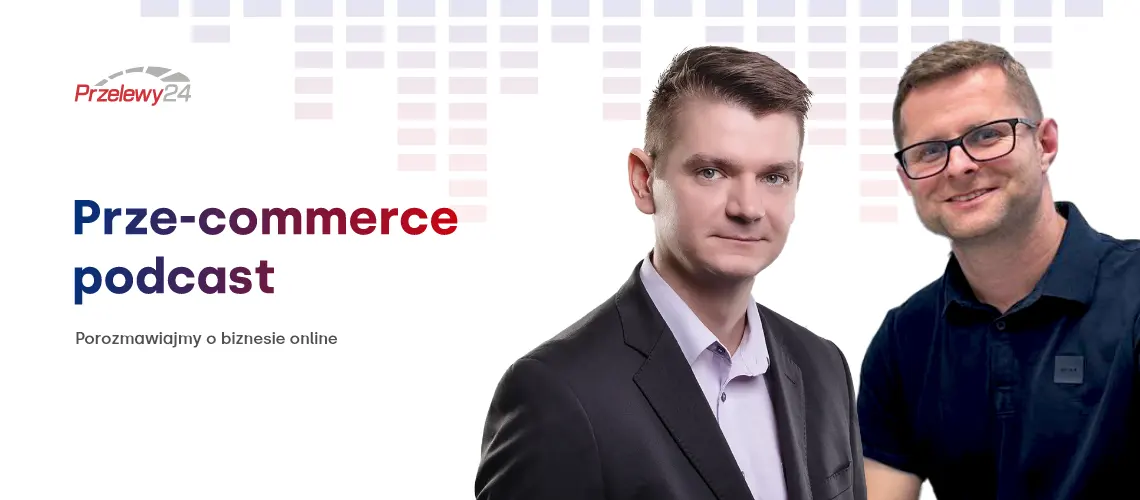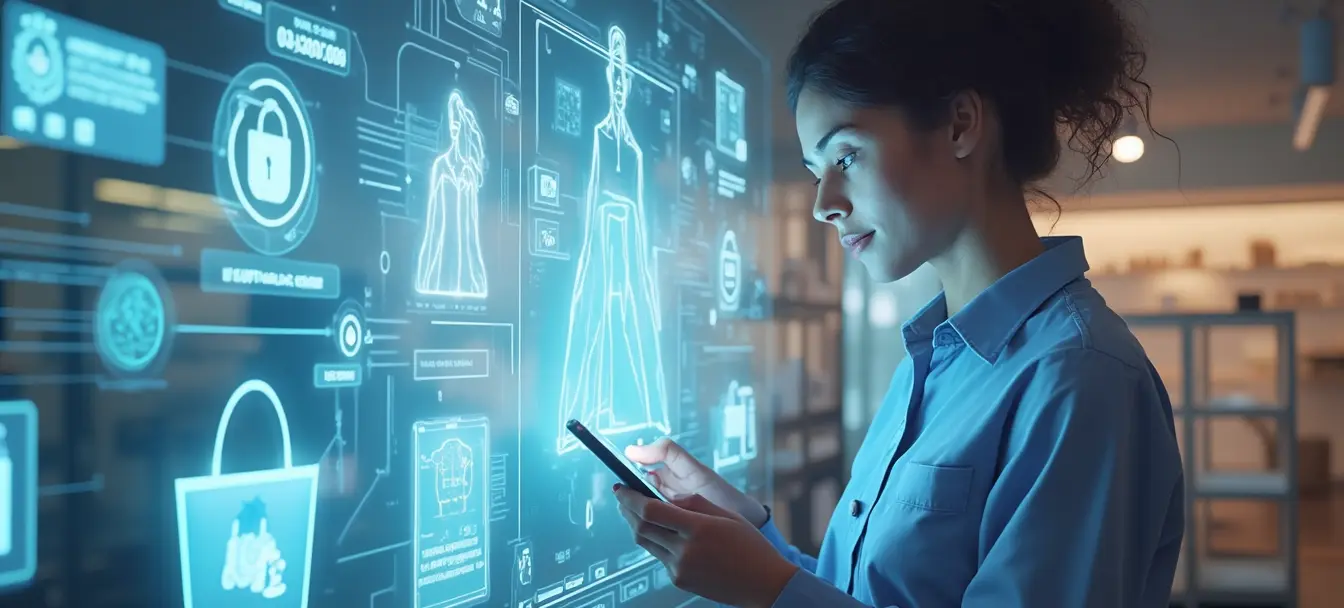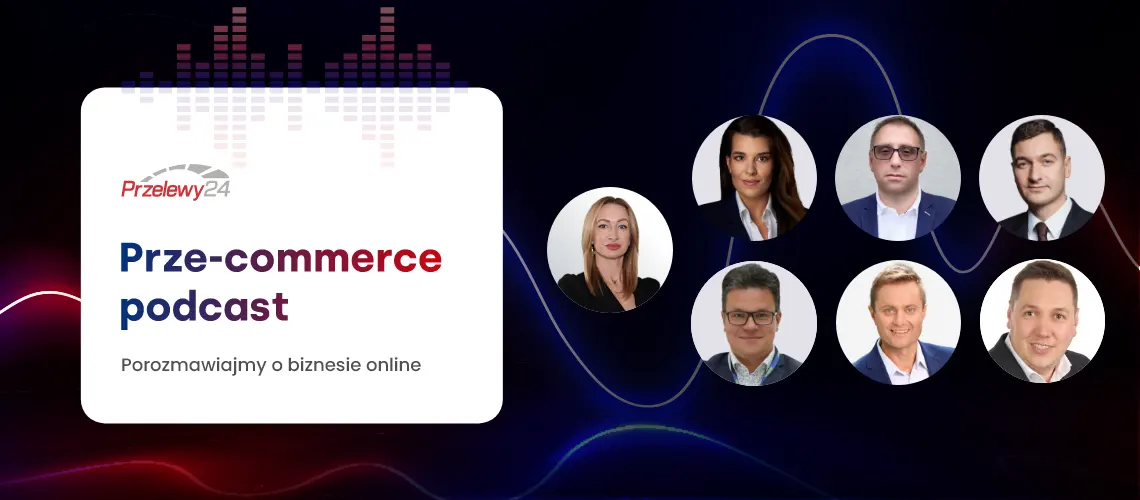Surprising connection: restaurateur and e-commerce?
What really connects a restaurateur closing a business and e-commerce? How has the pandemic forever changed our shopping habits and what really distinguishes a marketplace from an online store? We answer these and other questions in the latest episode of the "Przecommerce" podcast. Our guest is Tomasz Runowicz, the founder of the mohi.to company and a specialist in e-commerce, digitalization, and technology. In a conversation with Patryk Harasimowicz from Przelewy24, Tomasz talks about how to build a healthy business based on analytics, and about the three pillars that will revolutionize your strategy for the next two years.
The pandemic accelerated the revolution
The events of 2020 forever changed the world of commerce. Many businesses that had previously relied solely on offline sales had to move online. As Tomasz Runowicz says, this was a time of a massive leap in the number of new online stores and online sales turnover. It was then that the market was flooded with standalone solutions, such as WooCommerce or PrestaShop, but also, to the delight of less technologically advanced entrepreneurs, licensed platforms in the SaaS model, such as Shoper or Shopify, developed. This significantly lowered the barrier to entry into the world of e-commerce.
Another trend that gained popularity was marketplaces. Tomasz emphasizes that their main advantage is that they "already have customers," which was a quick way for many companies to reach consumers.
How to build a competitive advantage in the world of e-commerce?
Analytics and artificial intelligence – a perfect duo
According to Tomasz, the key to success in today's increasingly competitive world of e-commerce is analytics. It is this that allows for an in-depth understanding of customer behavior, tracking their shopping path, and making conscious business decisions. Access to tools such as Google Analytics or Hotjar allows not only for collecting quantitative data but also qualitative data, for example, by viewing video sessions of users.
What's more, the technological revolution doesn't end with analytics. As our guest emphasizes, artificial intelligence (AI) is already ubiquitous and supports e-commerce at every stage - from hyper-personalizing the website, through automatic content generation, to optimizing processes, e.g., handling returns.
From omnichannel to Unified Commerce
The concept of Unified Commerce also appears in the conversation. What is it? It is a further evolution of omnichannel, which is the combination of the online and offline worlds to give the customer a consistent experience. Unified Commerce goes a step further and aims to unify all points of contact between the customer and the brand - from the physical store, through the online store, to shopping on social media, for example on TikTok. This is a trend that is gaining importance, as younger generations are increasingly making purchases directly on social media platforms.
Three pillars of success for the coming years
At the end of the conversation, Tomasz Runowicz summarizes what is absolutely crucial for anyone who wants to stay and grow in the e-commerce industry. What are the three pillars on which to base your strategy for the next two years?
- The foundation of the business is analytics.
- Think globally! Limiting yourself to the local market in the face of global competition is short-sighted.
- Use technology and artificial intelligence to build a competitive advantage. Don't be afraid to experiment!
Watch the full episode on our YouTube channel Przelewy24_Official and learn more about the future of e-commerce: https://www.youtube.com/watch?v=6GSQpOXiNvo
Full podcast transcript:
Patryk Harasimowicz: Welcome everyone to the "Przecommerce" podcast on the Przelewy24 channel. My name is Patryk Harasimowicz and I am responsible for the technical, implementation, and product development areas of solutions for popular sales platforms. Today my guest is a phenomenal person with whom we cooperate in several categories of products delivered for sales platforms: a specialist in e-commerce, digitalization, and technology, Tomasz Runowicz, the founder of the mohi.to company.
Tomasz Runowicz: Patryk, you can intimidate a guest, I must admit I felt very honored. Thank you very much for the invitation, I'm glad I can take part in another episode.
Patryk Harasimowicz: I would like to express my appreciation for you, so I allowed myself to put it all into nice words. In today's episode, we will talk about trends, especially in e-commerce, about emerging opportunities and about the direction in which online sales are heading. We will also touch on the topic of conversion, the impact of technology on its increase, and analytics, which helps to understand the behavior of users and payers. We will also talk about standalone solutions, how the pandemic contributed to the development of e-commerce, and about market trends, including sales on marketplaces.
Tomek, let's start with your assessment of e-commerce years ago. It seems to me that I correctly pointed out the moment of increased customer awareness that occurred during the COVID-19 pandemic. It was then that healthy offline commerce had to find online sales channels. What is your opinion on the trends that are taking place?
Tomasz Runowicz: Yes, although today's episode is very technological and futuristic, let's start with history, as you mentioned. The year 2020, which we all remember, brought a huge change in the world of e-commerce. Well-prospering, classic sales models, i.e., retail points and broadly understood offline, were limited by regulations. Businesses had to function, and the natural direction in which brands turned was the online world, i.e., broadly understood online stores. This was a moment when both the number of online stores being set up and online sales turnover literally skyrocketed. There was a huge jump in sales, and everyone wanted - and even had to - appear online and face the new reality. This caused a huge number of new online stores to appear on both the Polish and global markets.
As they say, necessity is the mother of invention, and times of crisis mobilize us to look for new solutions. As a result, an ambitious group of companies emerged that had to find technological solutions corresponding to their business models. This was channeled in two ways. First, a lot of classic online stores of various qualities were created, because for many brands these were their first steps online. Second, many of them used marketplaces as a slightly shorter route. This growth therefore concerned both online stores and marketplaces.
Entrepreneurs had to enter the world of technology, which at that time was strongly represented by standalone solutions, such as WooCommerce, PrestaShop, or the more developed Magento. The common feature of these solutions is that they required a large dose of technological knowledge, which entrepreneurs often did not have. So they used external services or tried to build these stores themselves. This was a big barrier to entry. Licensed solutions, so-called SaaS (Software as a Service) solutions, came to the rescue. The most popular example on the Polish market is Shoper, and worldwide it is Shopify.
The common feature of these solutions is the ease of access to technology and the lack of need to learn it in depth. The customer bought a ready-made product and could focus on their business, marketing, products, and customer service. This took the necessity of understanding and developing technology off their shoulders. This significantly lowered the entry threshold, which led to a huge increase in the number of e-commerce.
Marketplaces were also added. On the Polish market, the biggest player, Allegro, had a ready-made offer. A marketplace differs from a store in that it already has customers. We enter with our product offer and have access to a customer who is ready to make a purchase. We get a ready-made technology, similar to SaaS, but we do not build our own brand. However, it is a quick way to reach the customer. These two elements meant that after 2020 a huge number of new e-commerce appeared on the market. It was a technological leap.
However, this state could not last forever. The change was forced by the situation and top-down regulations that blocked classic sales. After some time, the situation stabilized, but a large part of customers got used to the new way of shopping online. It can be safely said that this historical moment caused a huge acceleration in the awareness of customers who were convinced that online shopping can be just as convenient, and sometimes even more so, than in stationary stores. A large part of customers remained online.
Store owners returned offline. Now we are facing new challenges, because we have two different worlds: online and offline. Today, the e-commerce market in Poland is considered well-developed and dynamically growing, with 12–15% growth year on year. It is a market with a very well-educated community, both on the customer and store owner side. Poland also has its own specifics in terms of payments, with many Polish solutions that customers are used to, such as BLIK. We are at a very interesting moment, because we have to adapt to ever-increasing competition, using more intelligent solutions supported by artificial intelligence.
Patryk Harasimowicz: I completely agree. We, as Przelewy24, also cannot stand still. We provide solutions that connect these two worlds. If you looked from the perspective of the need to start your first online sale, the choice of platform was often spontaneous and without full know-how. What migration trends do you see? Is any technology now leading?
Tomasz Runowicz: You rightly noticed that decisions were often made under duress and not fully thought out, because there was no time for it. I remember the case of a client, a restaurant owner, who called us on Friday and said that from Saturday he had to close his business. We set up the store in three days so he could sell take-out meals. Of course, this was not preceded by deep analysis, he just had to deal with the situation at the time. This case may be extreme, but many store owners made hasty decisions that were not entirely adequate for their business model. It's hard to blame them for it, because they had to cope.
The second important issue is that someone without experience in online sales often transferred their offline solutions online. Or they tried to sell in the same way, or to forcibly adopt offline processes online, not understanding that the specificity of online shopping is different, and the context of the purchase may be completely different. For example, a buyer browses products on a small phone screen in a dark dressing room. Other aspects begin to matter for the attractiveness of the store.
Taking this into account, today these entrepreneurs have already matured in the new environment and have seen how much potential online sales have. I know cases where brands closed physical retail points because their maintenance was unprofitable, compared to revenues from the Internet. Now, when they have matured in this new reality, they are starting to see the shortcomings from the first stage.
If you ask about the migration trend, you can definitely see a large outflow from standalone solutions towards licensed solutions. We have two categories of such clients. The first are the less aware ones, who had a small solution, e.g., WooCommerce, which did not grow into a large store. Their teams are not technical, so they are looking for a licensed solution where technology does not matter. The technology is provided by the provider, such as Shoper or Shopify, so they can get rid of the problem.
The second group are larger, more conscious clients who also migrate to licensed solutions. They are primarily guided by cost optimization. It may turn out that although they have their own Magento, the costs of maintaining the infrastructure and the team are high, and the license fees are not much higher. Another issue is the unification of technology. E-commerce operates in a broader ecosystem, so the owner must manage several technologies and teams. So they are looking for a licensed tool that has these functions built-in and will allow them to unify it.
Therefore, we see an outflow towards licensed solutions. Shopify is currently the most popular platform in the world. Increasingly experienced clients are realizing that the uniqueness of their solutions is not always needed. Standardization and the use of good practices that Shopify tests based on its analysis give them a proven, ready-made solution that guarantees high conversion. Not every business model will allow for this, but we definitely see a trend of fleeing from custom solutions, because many clients feel they are their prisoners. They are fleeing to popular and purely licensed solutions.
Patryk Harasimowicz: Thank you Tomek for sharing this feedback and perspective. I understand that entrepreneurs were inexperienced, which is why they often chose open-source software, such as PrestaShop, Magento, or WooCommerce. The trends and possibilities of licensed solutions that you mentioned - Shoper, IdoSell, and also Shopify - mean that elements such as time consumption, cost reduction, and others resulting from the shortcomings of previous platforms, cause automation in licensed solutions to give greater peace of mind.
Selling on marketplaces gives access to a group of recipients and certainly boosts sales. However, it must be admitted that maintaining your own store, as a business card, is still important, and entrepreneurs are developing this sales channel on their individual platforms.
Technological and analytical trends are certainly the future. Can you tell us about the technologies and products that increase conversion and help to better understand where a given payer comes from?
Tomasz Runowicz: You touched on two elements that are related. The first is the issue of analytics, which in my opinion is still lagging behind many stores. They often have Google Analytics (GA4) connected to collect data, but they do not necessarily use it to the fullest. Analytics carries enormous value. A great advantage of e-commerce is its calculability, which we do not have offline. Offline it is difficult to identify whether a customer came from a given advertisement. Online we are able to assign many attributes to each entry to our website. We can monitor the source of the traffic, the campaign, how the customer moves around the website, what products they are interested in, and what they have added to the basket.
Thanks to this, we have a perfect tool for marketing activities. We can use marketing automation at every stage of the funnel, reaching the right person, with the right advertisement, and at the right time. We have tools such as Microsoft Clarity or Hotjar, which allow us to view user video sessions, which gives us qualitative data. We can see how they move around the website, what they are looking for, what they cannot find. We can use this to improve the UX, product descriptions, or photo galleries.
We have many great, and often free, tools at our disposal. GA4 is free, you just need to know how to integrate it and read the data. Store owners should analyze this data regularly, because it is on their basis that specific business actions can be taken. I believe that the basis of good e-commerce is the ability to read data.
The second issue is artificial intelligence, which is already everywhere. In e-commerce, it supports both us, as sellers, and the customer. Data analysis does not have to be done manually. Shopify has built-in systems (sight kick) that analyze user behavior and suggest which products are popular and which may soon sell out.
Artificial intelligence also enables website hyper-personalization. By identifying the user and their behavior, we can serve them unique, tailored content. It also supports the business itself, e.g., by generating content. Having a blog or writing posts on social media, which was a problem for many, has become very easy thanks to AI. You can generate ready-made articles, which of course should be reviewed, but it makes the work much easier. Artificial intelligence has huge potential and can support us at every stage of running a business.
Patryk Harasimowicz: So you encourage experimentation. Technology is supposed to support and help us, not replace us. Tomek, the online and offline sector forms a new omnichannel trend. Do you see any technological solutions or needs of your clients when it comes to this trend? First, however, let's answer what omnichannel is.
Tomasz Runowicz: Omnichannel is the result of the historical development of commerce. First, sales took place in physical stores, then, at an accelerated pace, they were moved online. After the revolution, store owners were left with two independent sales channels: physical and online. However, these two separate businesses should work together and play to one goal. Omnichannel is the combination of the online and offline worlds to bring synergy and give the user the same experience, regardless of the channel.
For example, if you see an advertisement online, you browse the store, but you want to try on the product, you go to a physical store. This is where the challenge arises. If you have a 10% discount as a loyal customer in the online store, you expect to be able to use it in the physical store as well. Unfortunately, for many brands, these are still two separate worlds. The customer comes to the physical store and wants to use a promotion they received online, and the staff have no information about it. This is the first challenge: how to connect these worlds, giving the user the same experience and rules, regardless of which channel they make purchases in.
The world is not standing still. Customers are very present on social media today, and sales through these channels are growing at a frightening pace. The challenge is for the customer who makes a purchase on TikTok or Instagram to have the same experience as at other points of contact with the brand. This is called Unified Commerce, which is a unified cognitive path of the brand. From a business point of view, we are talking about a customized backend that understands what the customer has done at each stage. For example, so that the warehouse knows what is happening on TikTok and what is happening in the offline store. This is a trend that must be followed. The younger the generation, the greater their presence on social media. We can't change that, we have to adapt to it.
Patryk Harasimowicz: I completely agree, both the generational aspect and payment behavior. Let's talk about it, because we at Przelewy24 also see trends, such as the increasingly frequent use of the subscription model and recurring payments. And also the differences in payments on desktops and mobile devices, which is a game changer for the young generation. Which of these trends is the most leading?
Tomasz Runowicz: Interesting question. I would put video-streaming shopping first. They currently dominate in Asia, but are rapidly distributing to the rest of the world. These are models where a purchase is made during a video broadcast, led by an influencer. The customer reaches the product without even knowing the store, through brand ambassadors. This is a dominant trend among the young generation, which is also starting to affect older generations, because it is simply convenient. We see the product in use and at the same time we can make a purchase without leaving the video. Your role, as Przelewy24, is to handle this transaction, for which you are ready. I would bet on that.
Patryk Harasimowicz: And when it comes to challenges and opportunities in e-commerce, what is every seller facing?
Tomasz Runowicz: The first thing is huge competition. In the past, e-commerce had a larger buffer for error, because margins were high. Today, competition is powerful and global. Chinese platforms, such as Temu, have caught up with and overtaken Allegro, which has been building its position for years. Competition and optimization are essential.
To deal with this, we need to focus on analytics. I recommend creating a well-calculated business budget, using the tools we talked about earlier. We can analyze which products have a low margin and maybe it's worth removing them, and also how to optimize the costs of delivery and returns. Returns are inextricably linked to e-commerce. Zalando, by popularizing free returns, influenced the entire market. There are industries where returns reach 80–90%. This is a huge capital commitment.
What can we do to optimize returns? Improve product descriptions, exposure, and add more information. Why? Because the reason for returns is often an ill-fitting size, color, or material. The reasons for returns should be analyzed, which store owners often omit. Polish solutions, such as Wygodne Zwroty, provide such analytics and suggest ideas on how to optimize the offer to have fewer returns. Every return costs money and customer dissatisfaction.
Therefore, I recommend a close look at every aspect of the business. Today, thanks to available technology, such as ChatGPT or Google Gemini, we can automate a large part of the analytical work. All you have to do is provide them with the right data.
The second thing is customer location. In the past, it was a common belief that it was enough to acquire a customer, and then forget about them. Nothing could be further from the truth. The cost of acquiring a customer is very high and will only grow. If we do not retain the customer and do not build their loyalty, we lose them and have to acquire another one. Therefore, I recommend focusing on building your own customer base, rewarding them, and expanding the business based on this.
Patryk Harasimowicz: When it comes to expansion, sellers often close themselves off to the local market. What opportunities and challenges does entering foreign markets bring? What would you advise sellers, should they enter foreign markets?
Tomasz Runowicz: With the exception of perhaps a few product groups, I believe that every e-commerce should think globally. We live in one large community. Europe has 500 million potential customers. We don't have to worry that sending a product to Spain will be a logistical nightmare. We can use many solutions. You, as Przelewy24, offer a multi-currency option and the possibility of selling in various currencies. This removes barriers to entering foreign markets.
Additionally, AI tools can translate the entire store and product offer in 15 minutes, adapting it to different countries. Limiting yourself to one country is short-sighted, because global competition is bombarding us. We have a number of ready-made solutions that allow you to sell throughout Europe, without the need to settle accounts in each country separately. If someone has ambitions, they can even operate overseas.
Patryk Harasimowicz: Thank you, Tomek. In summary, analytics opens up all possibilities. It allows you to understand customer behavior, segmentation, and personalization. New technologies automate everyday sales activities. What are the three pillars of building a company's strategy for the next two years?
Tomasz Runowicz: First, let's build a good foundation for our business based on analytics. In the second step, let's think globally, let's go abroad with our business, because we have the possibilities to do so. And third, let's use technology and AI solutions to build a competitive advantage. Let's not be afraid of them, because they serve us and allow us to boost sales.
Patryk Harasimowicz: Tomek, thank you once again for participating in our podcast. I invite you to the next episode of "Przecommerce" on the Przelewy24 channel. See you there.
Tomasz Runowicz: Thank you very much, Patryk, thanks a lot.



